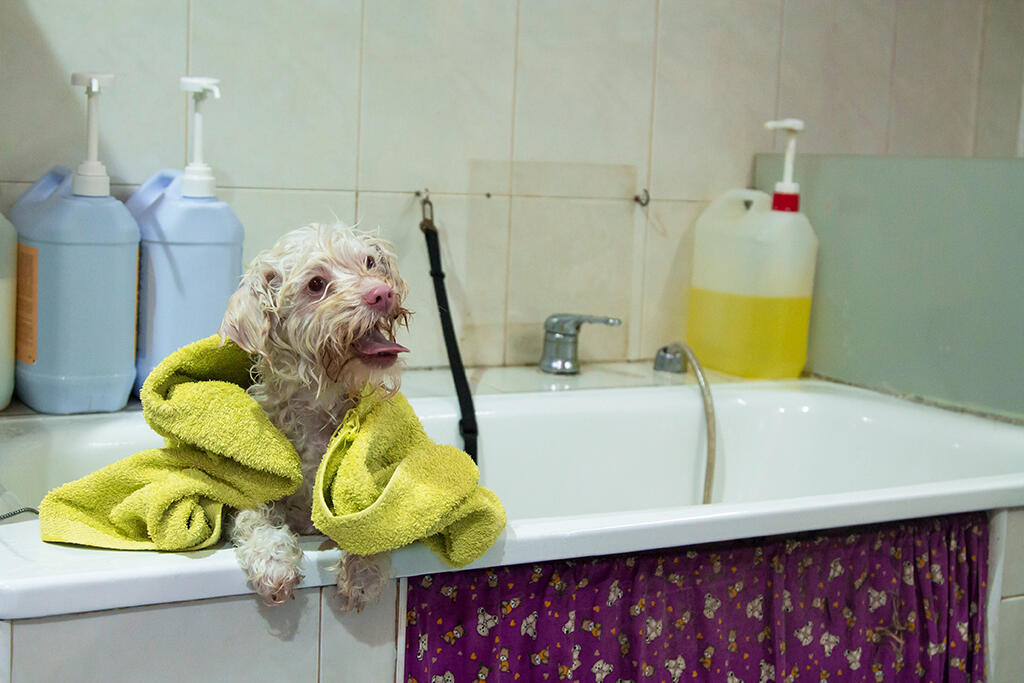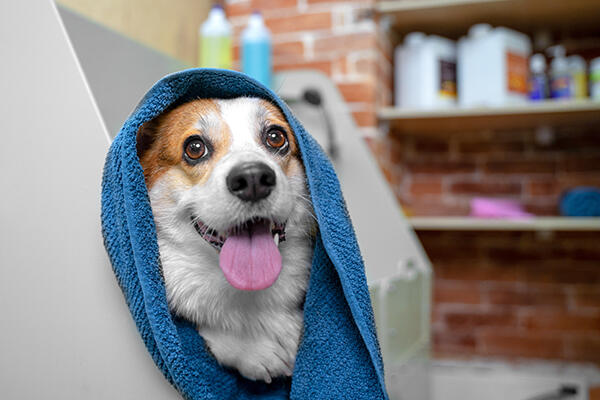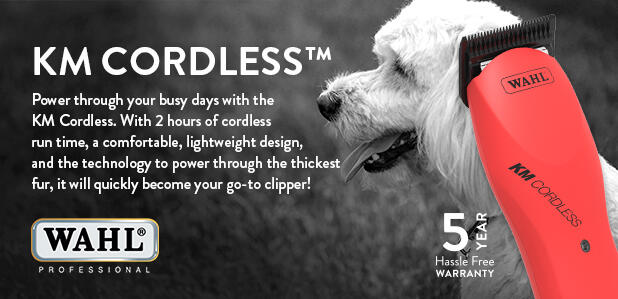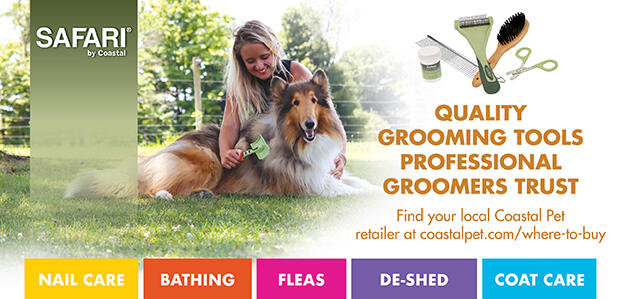How to maintain shelf life and prevent spoilage
By Dave Campanella, Best Shot Pet Products International

With over three decades in the grooming industry knowing what I know, some folks have deemed me as a pet shampoo guru of sorts. Admittedly, I sometimes get frustrated by any lack of shampoo common sense I observe within our growing industry. For instance, many groomers not only do not understand how their shampoo and conditioner work, but do not know how to properly care for and dispense them day to day. Allow me to explain.
Those of you who frequent online grooming forums may have noticed occasionally someone venting over their surprise, dismay, even anger concerning a spoiled bottle of shampoo? Often the assumption made is it was a “bad batch” or “the formula was changed.” Immediately others jump in to reply, “Off with their heads” or to say, “Try brand X instead.” Yet seldom is the subject of “proper dispensing and care” ever considered or even mentioned in any comments. Please hear me out.
Recently I had a discussion with a dog handler/groomer who would prep in advance by pre-diluting gallons of shampoo with tap water before heading out on the road to shows. She was surprised by how they smelled awful, separated, and became moldy after 1 or 2 months. My jaw dropped. I tried to explain what had happened without sounding judgmental but to no avail.
At that moment I realized she honestly and simply did not know any better. This got me thinking, “What of self-accountability?” In any grooming workplace, being accountable is a paramount quality. It mindfully works hand-in-hand with trust, reliability and responsibility.
In the healthcare industry serums, plasma, blood, vaccines, medicines, and other essential liquids are managed strictly, with precision and specific protocols. So where are the established codes of procedure within the grooming industry for safely caring for and dispensing pet shampoos and other grooming liquids?
While the COVID-19 world has certainly reinforced the importance of cleaning, disinfecting, and sanitizing in our salons; the same cannot be said for caring for grooming liquids. Sadly, the reality of shampoo spoilage often comes down to genuine ignorance and neglect by the user.
I would like to help remedy this by sharing some important facts, a few tips, along with some handy guidelines to follow. After all, “You don’t know what you don’t know.”
 Water Fosters Bacteria Growth
Water Fosters Bacteria Growth
Leonardo da Vinci reportedly said, “Water is the driving force of all nature.” Unfortunately, this includes harmful bacteria, too. Groomers must realize bacteria are the No. 1 enemy of shampoo and conditioner. Bathing areas are ripe breeding grounds for contamination.
For example, folliculitis is a common skin infection you may have come across characterized by small clusters of itchy bumps. These are typically caused by bacteria that amass in contaminated shampoo bottles due to unsanitary storage, dilution, and dispensing practices.
Pseudomonas is another bacterium that is responsible for many canine skin and ear infections. These bacteria are easily transferred in water and damp environments like wash tubs. There is an endless list of harmful bacteria that could amass in your on-hand inventory of grooming liquids. I will spare you from any further fear mongering other than to say how most claims of spoilage, and even client skin reactions from a product correlate to some lack or failure in one’s daily sanitation practices.
Preservatives Only Do So Much
Water volume can account for anywhere from 30 to 98 percent of a shampoo or conditioner’s formula; the remaining ingredient volume is referred to as “solids” or “percent of solid.” Did you know that conditioners have up to three or four times more water than a shampoo?
Shampoo and conditioner solids include plant-based detergents, conditioners, and fragrances, as well as polymers, minerals, and vitamins. It is important to acknowledge how plant and animal derived ingredients ultimately succumb to spoilage. There is no way around it. Even minerals and vitamins can oxidize and diminish in potency over time.
The role of a preservative is to postpone spoilage from overtaking a mixture within a reasonably designated time. This period is often referred to as a product’s “shelf life,” and is largely based on the products intended use and dispensing methods. A shampoo’s shelf life is not etched in granite given there are so many variables affecting them. They are nothing more than guidelines. Water alone will not spoil, but it will amass bacteria and other contaminants. These include dander, hair, condensation, heat, and oxidation. The presence of these pollutants rapidly exhausts the preservative far before ever reaching its anticipated shelf life.
It should come as no surprise that greater storage and dispensing care are required for ‘premium blends’ given they are more sophisticated formulas. These liquids have a higher percent of solids boasting more active proteins and extracts making them more susceptible to the spoilage variables I just mentioned.
Remember how the handler I spoke to said, “After 1 to 2 months” her gallons smelled rank. I assure you that within only 24 to 48 hours of pre-diluting her gallon mixtures they were teaming with bacteria. That is well before they notably began to smell foul.
Storage Guidelines
Fact: Grooming liquids contain proteins, botanicals, fragrance, essential oils, and other ingredients susceptible to heat, moisture, and pollutants. It’s not a matter of if they will spoil, but when.
- Wash and dry your hands before opening and closing shampoo bottles.
- Always store grooming liquids in a climate-controlled room (preferably well below 80oF, the cooler the better) because prolonged exposure to heat rapidly exhausts any preservative within the mixture, leading to premature spoilage.
- Freezing temperatures may also affect liquid performance. Upon receipt, examine your product packaging for damages or cracks due to freeze expansion. Compromised packaging typically leads to contamination, oxidation, and rapid spoilage.
- Always secure the lids tightly to prevent humidity and air borne debris from contaminating contents.
- Keep unused/unopened product in its original container. Avoid combining contents in unsavory bulk containers.
Water Quality and Dilution Guidelines
Fact: Tap water will vary by region and can sometimes hinder bathing results. High alkaline pH levels can be challenging for some shampoos. Call your water utility provider for a free quality assessment report or consider testing it yourself. Water testing strips are available online or at pool supply stores. It is important to know what you’re working with.
Adding water to shampoo compromises the mixtures overall preservative balance.
- Water quality factors like pH, mineral content, and bacteria levels influence product performance. This explains why many competition groomers and handlers often use bottled distilled water for consistency in results.
- Dilution rates are merely guidelines. It is not uncommon for most shampoo products to successfully stretch beyond what is recommended. Be encouraged to dilute to preference and to experiment with results.
- When diluting with water, only mix what is anticipated for each scheduled work session.
- Discard all unused diluted shampoo/conditioner within 24 hours.
Simple Dilution Guide
(N:1 means N to 1, or Add N parts water + 1 part shampoo)
Gallon Bottle Example:
Let us look at 10:1 dilution. In this case using a gallon bottle with 11 parts (10 parts water + 1 part product). Since there are 128 ounces in a gallon, divide 128 by 10, which will net a total of 12.8 ounces. Assuming you had 10 to 1 shampoo, you would add 12.8 ounces of shampoo (a tad more than 3 cups) to a gallon bottle, then fill it the rest of the way with water.
You can substitute any number into the N place of the formula and follow the logic above to calculate how much product is required with water. Remember, it is just a guideline
Quart Bottle Example
Using the 10:1 gallon example above, since there are 4 quarts in a gallon (128 divided by 4 = 32). Divide the 12.8 ounces by 4, and you get 3.2 ounces. Add 3.2 ounces (a tad more than ¾ cup) to a quart bottle, then fill it the rest of the way with water.
Note: 1 cup = 4 fluid ounces.
Tips When Using a Bathing System
Fact: Most pet shampoo work safely and effectively in any bathing system device. However, conditioners may not work in every unit due to oxidation causing the mixture to congeal and harden leading to build-up or clogging.
- Be certain all shampoo system maintenance and cleaning protocols are followed in accordance with the manufacturer’s specific guidelines.
- When using premix application systems like Cosmos® or Prima®, only mix what is anticipated for each scheduled work session. Please understand how contents will go rank if not depleted from each system within a reasonable time. Please adhere to manufacturer’s warranty guidelines.
- When using Metered bathing systems like BatherBox® or BathMaster® which syphon liquid directly from the gallon jug, make certain all fittings are securely fastened and do not leak air or moisture inside. Gallon jugs with loose or compromised fittings are more susceptible to contamination. Please adhere to manufacturer’s warranty guidelines.
- Recirculating bathing pumps like the original Hydrosurge® Pump or Bathing Beauty® require ongoing sanitizing. Please rinse clean and dry filters, nozzles, and hoses according manufacturer’s warranty guidelines.
- Please make sure there is no cleaning chemical residue left behind in your bathing system that could risk contaminating any shampoo mixture or irritating a pet’s skin.
Tips for Using Mixing Bottles
Fact: Misuse of mixing bottles is common among grooming salons and often leads to cross contamination.
- Designate a separate dilution bottle for each specific liquid product used.
- Do not reuse any empty bottles from another product. This helps avoid cross contamination.
- Avoid using squeeze tops because they can suck filthy water back into the mixing bottle.
- Use hot water and dish detergent for cleaning. The sanitize cycle on your dishwasher is most effective.
- Do not reuse empty bottles that contained bleach, disinfectant, pesticides, essential oils, ammonia, and/or peroxides for mixing shampoo. These tainted bottles will contaminate grooming liquids and should be disposed of.
Tips for Hand Pump Dispensers
Fact: Open pumps breathe, allowing air and condensation back into the container leading to unwanted spoilage.
- Make sure pumps are fully twisted shut or securely covered with a tied plastic bag when not in use.
- Designate one specific gallon pump for each product used to avoid mingling with other products and cross contamination.
- Write the product’s brand name on each dispensing pump or mixing bottle to match its designated gallon jug.
- The best way to clean reusable dispensing pumps is to disassemble then run through a hot dishwasher cycle.
- Do not clean plastic pumps with essential oils. Oils act as solvents, which soften plastic, making it porous and susceptible to harboring bacteria.
- Please be sure each pump is fully dry before placing them back into a gallon of product.
Tips for Managing Shampoo Inventory
Fact: Most shampoo manufacturers guarantee their products within 30 to 45 days from purchase. Try writing both the item purchase date and the day it was opened directly on the container with a permanent marking pen to keep track.
- Rotate your stock using oldest items first.
- During extreme weather months it is important to order from a supplier close in proximity. Shorter delivery times reduce the likelihood of damages and premature spoilage to your product.
- It is best to place orders earlier in the week rather than later. This reduces any likelihood of your order sitting in a delivery truck over a long weekend of sweltering summer heat or subzero freezing temperatures.
- Hold on to receipts for proof of purchase. You can often return or exchange defective product within warranty.
- Avoid making large bulk purchases beyond a 3-month supply. Turning your inventory more frequently reduces the likelihood of any unexpected spoilage and damage. Most grooming supply catalogs and warehouses offer very convenient 2-to-3-day delivery as well as free shipping options. This not only helps you maintain fresh inventory, but frees up your cash resources for other things.
Final Thoughts
Social media and the internet continue to influence our lives. They offer so many platforms to express personal opinions and bring common bonds together. Yet, despite all of the infinite opinions and information for us to rely upon, they typically fall short on accountability to truth and wisdom.
One of my favorite writers Harlan Ellison wrote, “You are not entitled to your opinion. You are entitled to your informed opinion. No one is entitled to be ignorant.” I whole heartedly agree with this statement. And Stephen Hawking even said, “The greatest enemy to knowledge is not ignorance; it is the illusion of knowledge.” Give that some time to settle into your mind. What do you think he was referring to?
Fortunately, truth, wisdom, and integrity still manage to prevail in pet grooming so far. What better way to strengthen our industry than by sharing knowledge and furthering one’s education. I am genuinely grateful to the many group forums, podcasts, digital publications, and websites that exist specifically for groomers. However, I would argue the need for more companies to come forward and grace these streams of content with greater knowledge for everyone’s benefit. I see a missed opportunity for industry leaders.
About the Author: Dave Campanella is an informative and entertaining seminar speaker, contributing trade columnist and genuine grooming enthusiast. He is Best Shot Pet Products sales and marketing director with 30 years of pet industry wisdom. He and his wife Tracy co-owned a full-service pet salon and self-wash in Ohio prior to relocating with Best Shot to Kentucky. Together they enjoy exhibiting at grooming shows, being industry ambassadors, and showing their Kerry Blue Terriers, Samoyed, and Lowland Polish Sheepdog.







